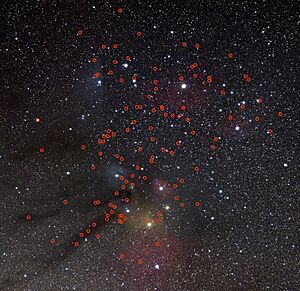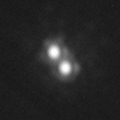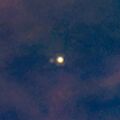Rogue planet facts for kids
Imagine planets that don't orbit a star! These are called rogue planets. They are also known as free-floating planets (FFPs) or isolated planetary-mass objects (iPMOs). Unlike Earth, which orbits our Sun, rogue planets travel through space all by themselves. They are not tied by gravity to any star or even a "failed star" called a brown dwarf.
Scientists believe there could be billions, or even trillions, of these rogue planets just in our own Milky Way galaxy! They might have formed around a star and then been kicked out, or they might have formed on their own in space, much like stars do.
Contents
What Are They Called?
Scientists use a few different names for these lonely planets. The most common ones are rogue planet, free-floating planet (FFP), and isolated planetary-mass object (iPMO). Sometimes, you might also hear them called "starless planets" or "wandering planets" in news reports. They all mean the same thing: a planet that's not orbiting a star.
How Were They Found?
The first rogue planets were discovered around the year 2000. Scientists from the United Kingdom and Spain found them almost at the same time. They used powerful telescopes like the United Kingdom Infrared Telescope and the W. M. Keck Observatory. These early discoveries happened in areas where new stars are forming, like the Orion Nebula. Later, in 2004, a team from the United States confirmed other similar objects first seen by a Japanese team in 1999.
How Do Scientists Find Them?
Scientists use two main ways to find rogue planets:
Microlensing
One clever way is called microlensing. This method uses the way gravity bends light. Imagine a distant star. If a rogue planet passes exactly in front of that star from our view on Earth, its gravity will act like a magnifying glass. It briefly makes the distant star appear brighter. Scientists watch millions of stars, looking for these tiny, temporary brightenings.
In 2011, a team of scientists found about ten planets roughly the size of Jupiter using this method. They estimated there might be about two Jupiter-sized rogue planets for every star in our galaxy! In 2020, they even found an Earth-sized rogue planet using microlensing.
Direct Imaging
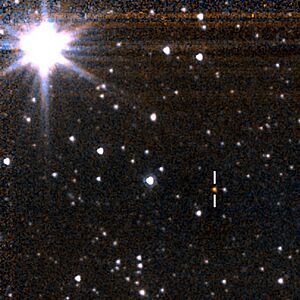
Another way to find rogue planets is by taking their direct image. This is like taking a picture of them! This method works best for planets that are still young and warm, as they give off more heat and light. Many of these are found in areas where new stars are being born.
Scientists can learn more about these planets, like their mass and age, when they can directly image them. Some of these young rogue planets, like OTS 44, have even been found with their own disks of dust and gas around them. These disks could one day form tiny exomoons orbiting the rogue planet!
How Many Are There?
Scientists have found hundreds of possible rogue planets. In December 2021, a large group of at least 70 rogue planets was discovered in a region of space called Upper Scorpius. These planets are between 4 and 13 times the mass of Jupiter. They are also quite young, only about 3 to 10 million years old.
Even more recently, in October 2023, over 540 new candidates were found in the Orion Nebula using the James Webb Space Telescope. These discoveries show that rogue planets are quite common in our galaxy!
How Do Rogue Planets Form?
Scientists have two main ideas about how rogue planets come to be:
Forming Like a Star
Some rogue planets might form in a similar way to how stars are born. Stars form from giant clouds of gas and dust that collapse under their own gravity. Scientists think that some smaller clumps in these clouds might also collapse to form planets, even without a star nearby.
The James Webb Space Telescope has helped scientists see that even very small objects, as light as 0.6 times the mass of Jupiter, might form this way. Sometimes, these young rogue planets are even surrounded by their own disks of material, which could eventually form tiny exomoons around them!
Forming Like a Planet (and then ejected)
The other main idea is that rogue planets start out like normal planets, orbiting a star. But then, something dramatic happens!
Imagine a busy planetary system with many planets. Sometimes, the gravitational pull between these planets can become very strong. This can cause one of the planets to get a powerful "kick" and be thrown out of its home system, becoming a rogue planet. This can also happen if another star passes too close to a planetary system, pulling a planet away.
Other Ways They Might Form
Scientists are still exploring other ways rogue planets might form. For example, sometimes young disks of gas and dust around stars might bump into each other. This could create long "bridges" of material that then collapse to form rogue planets.
It's also possible that some objects that started to form as stars or brown dwarfs stopped growing early. This could happen if they were kicked out of their birth cloud or if strong radiation from nearby stars blew away their gas and dust.
What Happens to Rogue Planets?
Most rogue planets will likely travel through the vast emptiness of space forever, never finding a star to orbit.
However, sometimes a rogue planet might pass very close to a star's planetary system. This is very rare! If it happens, the rogue planet might:
- Just keep going on its way.
- Get temporarily caught by the star's gravity, orbiting it for a while before being ejected again.
- Even "kick out" one of the star's original planets and take its place! But this is extremely rare and usually doesn't last long.
Could Rogue Planets Be Warm?
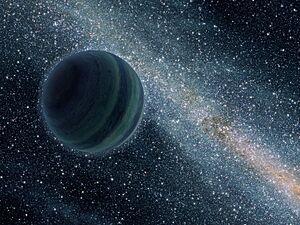
Since rogue planets don't have a star to warm them, you might think they would be completely frozen. But some scientists believe that certain rogue planets could actually stay warm enough for liquid water!
This idea suggests that if a rogue planet is big enough, like Earth, it could hold onto a thick atmosphere. This atmosphere would trap heat, much like a blanket. Also, the planet's own internal heat, from its core, could keep its surface warm.
If a rogue planet has liquid water, and perhaps even active volcanoes on its seafloor, it might even have the right conditions for life to exist! Finding such a planet would be very hard, though, because they don't give off much light or heat.
Images for kids
-
JuMBO 29, a candidate 12.5+3 Jupiter mass binary, separated by 135 AU, located in the Orion Nebula
See also
- Intergalactic star
- Interstellar object – an astronomical object in interstellar space that is not gravitationally bound to a star
- ʻOumuamua – an interstellar object that passed through the Solar System in 2017
- Rogue black hole – a gravitationally unbound black hole
- Rogue extragalactic planets – rogue planets outside the Milky Way galaxy
- Tidally detached exomoon – rogue planets that were originally moons


